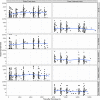Population pharmacokinetics of adalimumab biosimilar adalimumab-adbm and reference product in healthy subjects and patients with rheumatoid arthritis to assess pharmacokinetic similarity
- PMID: 32363771
- PMCID: PMC7576631
- DOI: 10.1111/bcp.14330
Population pharmacokinetics of adalimumab biosimilar adalimumab-adbm and reference product in healthy subjects and patients with rheumatoid arthritis to assess pharmacokinetic similarity
Abstract
Aims: Adalimumab-adbm is a monoclonal antibody developed as a biosimilar to adalimumab (Humira, AbbVie Inc.). The key objectives of this study were using a population pharmacokinetic (PPK) approach to assess pharmacokinetic (PK) similarity between adalimumab-adbm and Humira in patients with active rheumatoid arthritis (RA), to quantify the effects of potential covariates on adalimumab PK and to assess the impact of switching treatment from Humira to adalimumab-adbm on PK.
Methods: A PPK model was firstly developed using intensive PK data from the phase-1 study in healthy subjects (NCT02045979). PPK models were developed separately for phase-3 base study (NCT02137226) and its extension study (NCT02640612) in patients with active RA.
Results: PPK models were developed for adalimumab from adalimumab-adbm and Humira treatment in healthy subjects and RA patients. Weight and anti-drug antibodies were found to be important predictors of adalimumab clearance. Adalimumab PK was similar between adalimumab-adbm and Humira. The estimated effect of Humira on clearance, relative to the adalimumab-adbm, was 1.02 (i.e., Humira has 0.02 greater clearance). Similarly, the effect of treatment arms (switching) on clearance was estimated to be 1.00 and 0.997 for Humira:Humira:BI and Humira:BI:BI arms, respectively, relative to the BI:BI:BI arm (BI refers to adalimumab-adbm) in the phase-3 extension study.
Conclusion: PK similarity between adalimumab-adbm and Humira in patients with active RA was demonstrated using PPK approach. Adalimumab PK was also similar when switching treatment from Humira to adalimumab-adbm at either week 24 or 48.
Keywords: biosimilar; pharmacokinetics; rheumatoid arthritis.
© 2020 The Authors. British Journal of Clinical Pharmacology published by John Wiley & Sons Ltd on behalf of British Pharmacological Society.
Conflict of interest statement
There are no competing interests to declare. G.J. and K.‐H.L. are employees of Boehringer Ingelheim. J.K., R.J.E.‐B., J.M. and W.K. are employees of Metrum Research Group, which was contracted by Boehringer Ingelheim to perform these analyses and support preparation of this manuscript.
Figures




References
-
- U.S. Food and Drug Administration . Guidance for Industry: Quality Considerations in demonstrating biosimilarity of a therapeutic protein product to a reference product. Available at https://www.fda.gov/downloads/Drugs/GuidanceComplianceRegulatoryInformat...
-
- European Medicines Agency . Guideline on similar biological medicinal products containing monoclonal antibodies‐nonclinical and clinical issues. Available at http://www.ema.europa.eu/docs/en_GB/document_library/Scientific_guidelin...
-
- Wynne C, Altendorfer M, Sonderegger I, et al. Bioequivalence, safety and immunogenicity of BI 695501, an adalimumab biosimilar candidate, compared with the reference biologic in a randomized, double‐blind, active comparator phase I clinical study (VOLTAIRE®‐PK) in healthy subjects. Expert Opion Investig Drugs. 2016;25:1361‐1370. - PubMed
Publication types
MeSH terms
Substances
Associated data
Grants and funding
LinkOut - more resources
Full Text Sources
Medical

